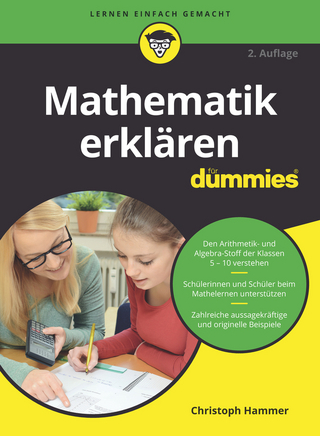
A Course on Borel Sets
Springer Berlin (Verlag)
978-3-642-85475-0 (ISBN)
- Titel wird leider nicht erscheinen
- Artikel merken
1 Cardinal and Ordinal Numbers.- 1.1 Countable Sets.- 1.2 Order of Infinity.- 1.3 The Axiom of Choice.- 1.4 More on Equinumerosity.- 1.5 Arithmetic of Cardinal Numbers.- 1.6 Well-Ordered Sets.- 1.7 Transfinite Induction.- 1.8 Ordinal Numbers.- 1.9 Alephs.- 1.10 Trees.- 1.11 Induction on Trees.- 1.12 The Souslin Operation.- 1.13 Idempotence of the Souslin Operation.- 2 Topological Preliminaries.- 2.1 Metric Spaces.- 2.2 Polish Spaces.- 2.3 Compact Metric Spaces.- 2.4 More Examples.- 2.5 The Baire Category Theorem.- 2.6 Transfer Theorems.- 3 Standard Borel Spaces.- 3.1 Measurable Sets and Functions.- 3.2 Borel-Generated Topologies.- 3.3 The Borel Isomorphism Theorem.- 3.4 Measures.- 3.5 Category.- 3.6 Borel Pointclasses.- 4 Analytic and Coanalytic Sets.- 4.1 Projective Sets.- 4.2 ?11 and ?11 Complete Sets.- 4.3 Regularity Properties.- 4.4 The First Separation Theorem.- 4.5 One-to-One Borel Functions.- 4.6 The Generalized First Separation Theorem.- 4.7 Borel Sets with Compact Sections.- 4.8 Polish Groups.- 4.9 Reduction Theorems.- 4.10 Choquet Capacitability Theorem.- 4.11 The Second Separation Theorem.- 4.12 Countable-to-One Borel Functions.- 5 Selection and Uniformization Theorems.- 5.1 Preliminaries.- 5.2 Kuratowski and Ryll-Nardzewski’s Theorem.- 5.3 Dubins — Savage Selection Theorems.- 5.4 Partitions into Closed Sets.- 5.5 Von Neumann’s Theorem.- 5.6 A Selection Theorem for Group Actions.- 5.7 Borel Sets with Small Sections.- 5.8 Borel Sets with Large Sections.- 5.9 Partitions into G? Sets.- 5.10 Reflection Phenomenon.- 5.11 Complementation in Borel Structures.- 5.12 Borel Sets with ?-Compact Sections.- 5.13 Topological Vaught Conjecture.- 5.14 Uniformizing Coanalytic Sets.- References.
| Erscheinungsdatum | 19.12.2018 |
|---|---|
| Reihe/Serie | Graduate Texts in Mathematics ; 180 |
| Verlagsort | Berlin |
| Sprache | englisch |
| Themenwelt | Mathematik / Informatik ► Mathematik ► Allgemeines / Lexika |
| Mathematik / Informatik ► Mathematik ► Geometrie / Topologie | |
| Mathematik / Informatik ► Mathematik ► Logik / Mengenlehre | |
| Schlagworte | ALEPH • arithmetic • Axiom of choice • cardinal number • Countable set • Equation • Function • Functions • Metric Space • Morphism • reflection • selection • Time • Topology • Transfinite induction |
| ISBN-10 | 3-642-85475-3 / 3642854753 |
| ISBN-13 | 978-3-642-85475-0 / 9783642854750 |
| Zustand | Neuware |
| Haben Sie eine Frage zum Produkt? |
aus dem Bereich


